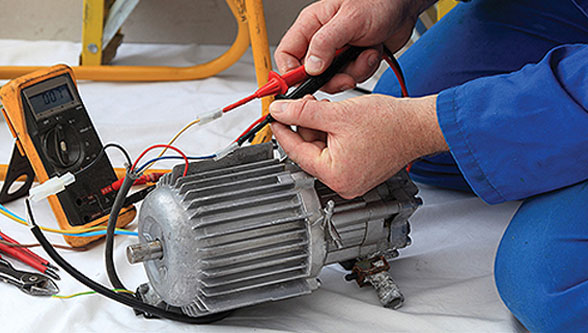As a preventive measure, even the most basic motor testing methods can yield savings in time, maintenance and repair costs. That’s to say nothing of the potential cost cuts in areas like energy usage, equipment lifespan and facility productivity.
Testing is equally important after a piece of equipment fails or malfunctions during operation. Intermittent failure to start or operate, excess heat, electrical problems and strange vibrations all call for intervention. However, you need to be able to target your efforts.
Motor problems might originate in any one of the following areas:
- A seized motor from dirt or debris
- Faults from burned wires, corroded connections or deteriorated insulation
- Motor controllers
- Power supplies
- Branch circuit connectors
Checking the alignment, lubrication levels and electrical performance of your motor can help you spot maintenance items during scheduled checks or diagnose a problem machine after it develops unexpected behavior. With that in mind, here are some useful motor testing methods worth knowing.
What to Know About Testing Your Motor
You may already appreciate the wide range of diagnostic tools in the world today for troubleshooting motor problems. Temperature sensors, winding analyzers, oscilloscopes and clamp-on ammeters are just some of the available choices.
As we get into ways to use these tools in specific testing methods, remember to use your senses first. Is the motor overheating or is one component hotter than it should be? Is there an unusual smell or sound? Have you witnessed erratic behavior?
Many technicians can narrow down their search using their senses, followed by a pass with the multimeter to look at things like resistance, voltage and power levels.
The trick is avoiding motor failure in the first place — along with unproductive and unprofitable downtime. If you want to keep your maintenance costs reasonable and your business humming, invest in ongoing testing protocols as well as structured workflows at the first sign of trouble.
Here are some of the techniques you can implement while keeping the impact on your processes to a minimum.
1. Hipot Test: For Evaluating Dielectric Strength and Cable Insulation
You can use high potential (hipot) testing, also called dielectric strength testing, to detect weaknesses in as well as the likelihood of failure of wire and cable insulation. Hipot testing generally follows insulation resistance tests and a visual inspection.
In the hipot test, technicians use AC or DC voltage to apply current between an electrical circuit and the frame of the equipment. This tests for leakage current and provides clues about how soon the motor’s insulation will require professional replacement.
Typically, hipot testing is applied only once at full strength and then subsequentially at 85% strength or lower, to avoid overtaxing and damaging the insulation. Reconditioned insulation should be tested at 60% or lower.
2. Voltage Drop Test: For Analyzing Resistance in Circuits
Of the motor testing protocols named here, voltage drop tests can be some of the most cost-effective, straightforward and useful to carry out. Technicians can perform the analysis using a digital voltmeter and a basic load, revealing areas along a circuit where voltage — or useful power — is getting lost along the way. The results of a voltage drop test can signify the need to clean and repair a motor, or carry out other maintenance.
Electrical motors are especially vulnerable to voltage drops and eventual burnout in industries where equipment operates 24/7/365, such as manufacturing. Continuous operation puts stress on circuit connections, affecting their resistance and causing a loss of power. Regular testing is key to keeping this and related problems at bay.
3. Surge Test: For Detecting Burnout and Isolating Shorts
Shorts in motor conductor turns and problematic conductor insulation serve as early warning signs of electrical degradation. Chemical deposits, rewinding errors, heavy use and manufacturing defects can all compromise motor windings or cause them to fail before their time.
Surge testing may be used to detect burnout as well as predict the likelihood of motor failure in the future. It allows operators to find shorted conductor turns and pinpoint failed or failing insulation.
IEEE 522 describes the safe and consistent way to apply a voltage surge or pulse to motor windings to isolate and appraise their performance.
4. Core Loss Test: For Appraising Equipment Reliability
It’s fair to say that core loss can be one of the most significant sources of energy waste in manufacturing systems powered by electric motors. Also called a core flux test or a core test, this testing method is typically required during motor rewinding. However, it can be useful at any other time to appraise the power output and, therefore, the reliability of an industrial motor.
All industrial motors experience small degrees of energy loss at one point or another, but sustained or abnormal power performance points to core loss. There may be underlying physical damage, winding or rewinding defects, and potentially overheating somewhere in the motor.
The IEEE 432 and EASA AR-100 standards both describe how to perform industry-compliant core loss testing on motors. Among other things, repair shops are encouraged to use thermal imaging cameras to verify that hot spots have been properly addressed.
5. IoT Analysis: For Performing Ongoing Motor Testing
As the saying goes, an ounce of prevention is worth a pound of cure. With that in mind, we wanted to take what would have been a conversation about another type of motor insulation resistance test — Megger testing — and turn it toward the larger world of embedded and automatic motor testing systems.
Using Internet of Things (IoT) platforms to gather resistance, temperature, vibration and voltage data on an ongoing basis is beneficial for several reasons. It allows maintenance staff to carry out repairs and parts replacements on a proactive basis, thereby preventing processes from grinding to a halt later on.
Ongoing Megging, or insulation resistance (IR) testing, benefits manufacturers and other operators of industrial motors and pumps by creating a historical record of machine metrics. Compared to spot tests, ongoing testing automatically corrects for temperature and other environmental variables. This leads to truer and more useful datasets and a clearer understanding of how critical machines operate over time.
Why Motors Fail and How to Prevent It Next Time
Detecting the nature and cause of an industrial motor failure is high-value work. With the right testing protocol, and perhaps the correct technology, technicians can maximize equipment investments, save money and prevent dreaded downtime. There are many reasons why motors might fail, but ongoing manual or automated testing will decrease the likelihood of that failure taking your operations down with it.
Article by —

Megan Ray Nichols
Freelance Science Writer
nicholsrmegan@gmail.com
www.schooledbyscience.com/about


